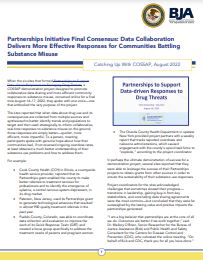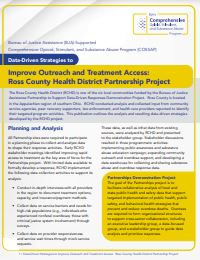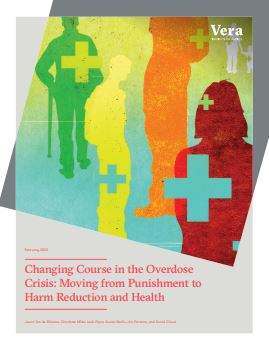Establishing cross-sector partnerships that promote collaboration and enhance information sharing is a critical component in any community’s successful approach to combating the opioid epidemic. These multidisciplinary collaborations facilitate the sharing of timely and accurate data and enable public safety, public health, and behavioral health agencies to leverage their distinct and complementary roles and capabilities to respond effectively to the opioid crisis and other emerging drug threats.
The Partnerships Initiative, funded by the Bureau of Justice Assistance, supported cross-sector teams in six local communities and strengthened the data collection and analytic capabilities of public safety, public health, and behavioral health agencies. This initiative also enhanced the ability of these selected communities to implement, coordinate, and tailor rapid responses to reduce overdose deaths.
The Partnerships Initiative began September 1, 2019, and most sites concluded their activities by February 8, 2023. One site was extended to March 15, 2023.
Reducing overdose deaths by enhancing collaboration and information sharing between public safety, public health, and behavioral health and supporting coordinated cross-sector intervention strategies.

Oneida County Opioid Task Force—A Brief: Putting Data to Action
This brief presents an overview of the data-driven work of the Oneida County (New York) Opioid Task Force and provides guidance for communities seeking to replicate some of the activities. Information in the brief includes topics such as the Oneida County Opioid Task Force's Overdose Response Team, the Overdose Detection Mapping Application Program (ODMAP) and other real-time data collection and surveillance activities, data and information sharing tools, and the ways in which the Oneida County Opioid Task Force puts the data into action.
Read Brief
Consensus of Partnerships Initiative: Data Collaboration Delivers More Effective Responses for Communities Battling Substance Misuse
The six sites that formed Partnerships to Support Data-driven Responses to Emerging Drug Threats, a COSSAP demonstration project designed to promote collaborative data sharing and more efficient community responses to substance misuse, convened online for a final time August 16–17, 2022. Learn more about the demonstration project's purpose and successes, as well as details of the sites' work.
Read Article
Data-Driven Strategies: Data Sharing to Address Current and Emerging Drug Threats: Pueblo County, Colorado
The Pueblo Department of Public Health and Environment (PDPHE) is one of six local communities funded by the Bureau of Justice Assistance Partnership for Data-Driven Responses Demonstration Project. This publication describes PDPHE’s activities to create a robust, near real-time data collection and information sharing infrastructure for public safety, public health, and behavioral health partners.
Read Article
Data-Driven Strategies to Improve Outreach and Treatment Access: Ross County Health District Partnership Project
The Ross County Health District (RCHD) is one of the six local communities funded by the Bureau of Justice Assistance's Partnership to Support Data-Driven Responses Demonstration Project. RCHD conducted analysis and collected input from community service agencies, peer recovery supporters, law enforcement, and health care providers to develop data-driven strategies to prevent and reduce overdose deaths.
Read Article
New Oneida County Dashboard Tracks Key Information on Drug Overdoses and Trends
WSYR-TV reports on a new dashboard showcasing public-facing data that tracks key information about drug overdoses and trends in Oneida County, New York.
View Report
New Report
The Vera Institute of Justice, with the support of the Robert Wood Johnson Foundation, has released a new report examining the intersection of drug use and the criminal justice system. The report Changing Course in the Overdose Crisis: Moving from Punishment to Harm Reduction and Health highlights case studies from two communities on their response to overdoses that prioritizes community health, harm reduction, and recovery.
View Report